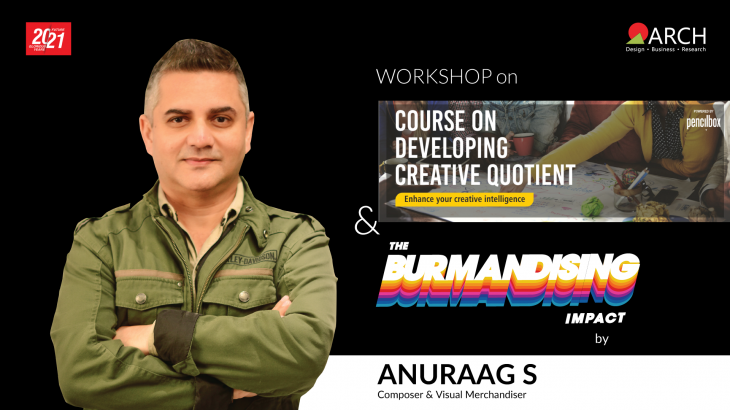‘The Burmandising Impact’ was an idiosyncratic session organized on Saturday 13th of February at Arch College of Design and Business on the campus itself. The idea behind the symposium was in fact the brainchild of notable visual merchandiser and musician Anuraag S.
An avid admirer of R. D. Burman’s music, Anuraag bisociated the work ethic of his with the art of R. D. Burman, the simultaneous mental association of an idea or object with two fields ordinarily not regarded as related. The pun is perhaps the simplest form of bisociation. Fondly known as Pancham da, RD’s commercial success during his lifetime and worldwide posthumous acknowledgment inspired the ‘then’ youth of India, including a young Anuraag’s embarking on a design thinking journey. After spotting a genius in RD, Anuraag kept exploring music and conceptualizing his theories along the way. If you’re a master of any field, you can break the rules. Anuraag S who identifies himself as ‘momosexual’ quoted that ‘Music is the simplest means of understanding ‘design thinking’ which is a way of life’. Directing the students to prepare themselves for the upcoming challenges of the design realm, Anuraag shared amusing anecdotes of his journey as a visual merchandiser and how RD’s genius roused a quirky way of looking at challenges. Appreciating the legendary music director, Anuraag S had 11 ‘learnings’ or guidelines which he formulated as a part of his cognizance of visual merchandising and fandom of vintage Bollywood music, he thoroughly explained each theory with a song, finding deeper learnings and a different perception of it, which inspired the students to think out of the box and way beyond their years.
It’s often said that true genius lies in simplicity. No one embodied that spirit better than Pancham Da. There were incredibly intense and complex compositions like ‘Chingari Koi Bhadke’ from the super hit 1970 classic ‘Amar Prem’. However, there were also songs like ‘Ek Ladki Ko Dekha Toh Aisa Laga’ from the film ‘1942: A Love Story’, which consists of one melody that repeats right through the song. As the legendary lyricist Javed Akhtar once said: “A certain minimal quality is what you’ll find only in the masters and only those artists who are totally self-confident. There is no room for desperation or fear. That’s all one needs.”A fundamental quality of any great composer is his/her ability to enhance and accentuate an artist’s best qualities. In the hit documentary ‘Pancham Unmixed’, singers and fellow session musicians elaborately speak of an absence of ego while making music, despite his obvious gifts. Receptive to new ideas, treating fellow artists with empathy and respect and constantly seeking inspiration from everyone around – working with Pancham was an exercise in collaborative brilliance.
What puts RD above and beyond everyone else is his ability to amalgamate genres from all over the world into his music. Pancham’s mastery of classical music is well known, but he also religiously injected elements from rock, funk, jazz, disco, afrobeat, folk and a myriad of Latin American music forms into his songs for mainstream cinema and private albums. Nowhere was this more apparent than in the 1975 Bollywood classic Sholay, where he composed and sang the immortal ‘Mehbooba Mehbooba’. From a composition standpoint, it was yet another example of innovation and discovering sounds from everyday life. In the initial rhythm segment of the song, what you’re hearing is musicians blowing rhythmically into half-filled beer bottles. Subsequently, you hear the Iranian santoor, but different from its traditional tone. Finally, you get to Pancham’s voice, and those distinct accentuated vocals come through. Long before the advent of autotune and other recording technology, Pancham was doing some remarkable things with the human voice. What made Pancham such an innovative producer is that he never limited vocal performances to just traditional singing. Songs like the immortal ‘Duniya Mein Logon Ko’ from the 1972 film ‘Apna Desh’ were game changers with RD’s unusual voice and unique rendering. What we hear here is ‘scat singing’ (vocal improvisation with wordless vocals, nonsense syllables) straight out of vocal jazz. Pancham made scat singing fashionable for future music composers. In line with the anecdotes from his visual merchandising journey, Anuraag S made an epitome out of how can one learn so much from their surroundings, added a few names to the legendary musician’s fan base. This lucrative session was a just conclusion to the 2-day creative ‘design thinking’ workshop taken by Anuraag S with great éclat. The students, both current and former were treated with a brunch after the end of the session. An after-party was then held for alumni and staff making it a memorable day at the Arch College of Design and Business.
